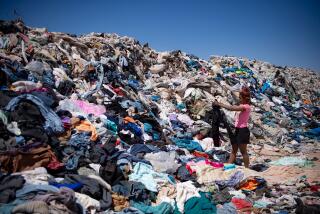Dumpers Heap Abuse on City in ‘Ugly Zones’
Lying low in the Otay Valley, below the brown, scrubby hills, is a refrigerator.
And a couch.
And a chair.
And a case of motor oil, oozing petroleum.
The menagerie of discards nestles right up to a sign that says: “Litter and illegal dumping subject to prosecution.”
It’s almost as if the lawbreakers are daring the law, ridiculing whatever august body had the audacity to post that sign.
Illegal dumping is a growing, spreading problem in San Diego County, according to sheriff’s deputies and overseers of solid waste. The area that may be hardest-hit by “dumpitis,” as one official cynically called it, is the Otay Valley--less than a mile from a county landfill.
“It’s a big, big concern,” said Helen Bird, administrator for the City of San Diego’s litter control program. “And, it’s very prevalent. It’s a problem citywide . . . countywide. It happens anywhere and everywhere. People just aren’t discreet about where they dump.”
Biggest ‘Ugly Zones’
She said the biggest “ugly zones” are Southeast San Diego (60th and Radio) and many of La Jolla’s pristine canyons. Areas along Black Mountain Road in Rancho Penasquitos are craved by dumpers, who in that location render helpless the owners of private property.
“If dumping occurs on private property, it then becomes the responsibility of the owner,” Bird said. “It’s the owner who’s fined. The dumper would get fined only if we could catch them.”
Like Mangy Cats
Bird said dumpers crave canyons and crevices, which offer shelter from enforcers. Like the mangy cats who prey upon their refuse, the dumpers also prefer the night, and the cover of darkness.
“They don’t really care whether a neighborhood is nice or not,” she said. “And they don’t care much at all about fellow human beings.”
Bird manages five city inspectors, who, in the first quarter of the current fiscal year--July to October--”abated,” or removed, 1,229 illegal dumps in San Diego proper. That marks a 10% increase over the same period a year ago. She said the biggest problems posed by dumping are its danger to others, not to mention how it hammers the landscape.
“If we hear of a refrigerator being dumped, we check that out immediately,” she said. “Who knows, a child might be inside. Children are curious. They see a refrigerator, they climb inside, the door shuts. Hazardous wastes are also a worry.”
Flammable liquids such as gasoline or motor oil often ignite. Illegal dumping usually occurs near dry, scabby land, so brush fires are a constant concern.
Why is illegal dumping occurring with greater frequency?
The city landfill, at the north end of Convoy Street, used to be free. Now, fees are assessed based on weight. A carload might bring a $3 charge; a truckload, $5, as much as a ton, $10.
William Sterling is deputy director of the city’s waste management department and the overseer of the Miramar Solid Waste Disposal Facility, otherwise known as the landfill.
Are people dumping illegally to avoid the fees, which took effect in July?
“I don’t think people are out littering the countryside to avoid (the fees),” said Sterling, who explained that the landfill is privately owned, without funding from taxpayers. “I think most people understand the need to dispose of refuse in a proper and safe manner. If people
are going out and breaking the law, scattering trash all over creation, just to avoid paying $3 or $5, well, that’s a sorry state of affairs.”
‘Nagging Worry’
Bob Allen is solid waste manager for San Diego County. He said illegal dumping is a “nagging worry” throughout the county and threatens to get worse, especially in the Otay Valley. One of the biggest questions, he said, is how to enforce anti-dumping laws, a feeling repeated by deputies from the sheriff’s department.
“If you can’t pinpoint evidence in the dump itself, tracking the crime to a violator, it’s almost impossible to remedy, unless you actually see the person doing it,” Allen said. “Most of it goes on at night, for that reason. It’s a concern, for reasons of aesthetics as well as health. And, of course, the cost of cleaning it up falls on the taxpayer.”
Allen said the county operates five landfills--in Santee, San Marcos, Ramona, Borrego Springs and the Otay Valley. All charge fees comparable to the city’s.
Allen said illegal dumping is a misdemeanor, covered by state and county ordinances. The state fine is $500, the county’s $50.
So, the question is, who dumps--illegally?
“People removing trash of any sort,” Bird said. “People not wanting to pay a fine. People not wanting to drive all the way up to the landfill. People who do yard work and don’t know what to do with the refuse. People who clean out a house and don’t know what to do with old furniture. And, of course, slobs--people who just don’t care what happens to a mound of trash after it leaves their hands.”
More to Read
Sign up for Essential California
The most important California stories and recommendations in your inbox every morning.
You may occasionally receive promotional content from the Los Angeles Times.










